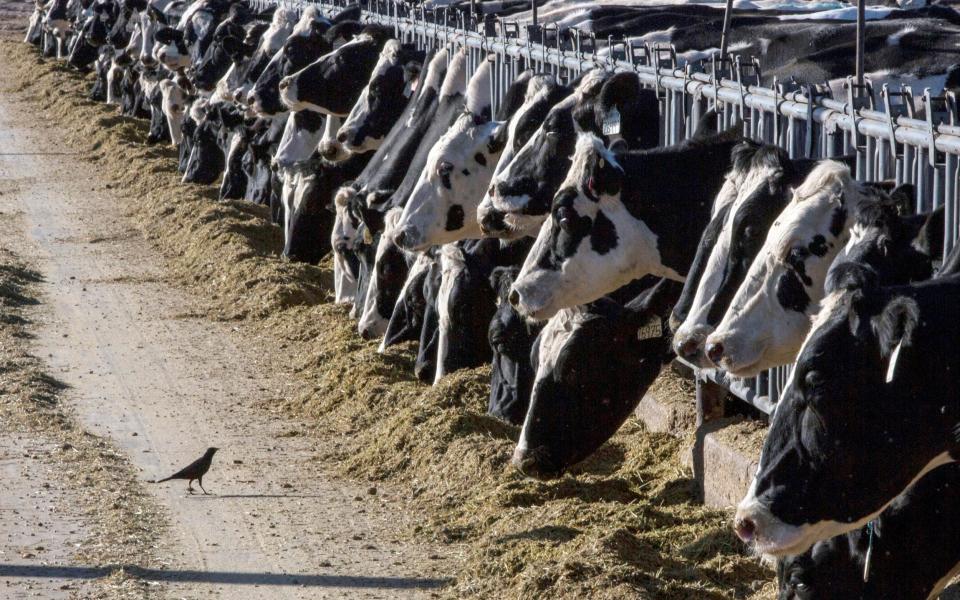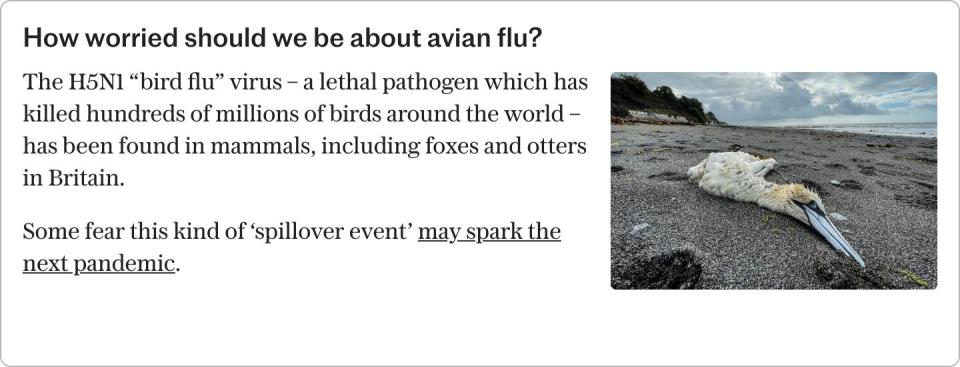Scientists are trying to understand the rapidly evolving bird flu situation in North America as the first laboratory-confirmed human case of H5N2 emerged.
A 59-year-old man in Mexico City died from the bird flu strain – previously unknown to infect humans – after contracting the virus from an unknown source, health officials say.
According to a report from the World Health Organization (WHO), the patient apparently had no previous exposure to poultry or animals and had been in the hospital for almost a month before becoming ill.
The H5N2 virus, a different strain from the H5N1 virus currently circulating among U.S. dairy cattle, has been found in poultry farms across Mexico in recent months — which experts suspect could somehow be the source of the infection .
“Anytime avian influenza viruses circulate among poultry, there is a risk of infection and small clusters of human cases due to exposure to infected poultry or contaminated environments,” the WHO said.
“While this new case is quite unusual in that it is the first known human infection with H5N2 and the individual has not had any known exposure to animal sources, it is reported that the individual had multiple other health conditions that may have made him particularly vulnerable. ” says Prof. Peter Horby, Director of the Pandemic Sciences Institute at the University of Oxford.

H5 viruses, a subtype of influenza A or ‘bird flu’, mainly infect wild birds such as ducks, geese and swans.
When they spread to domestic birds such as chickens and turkeys, they can cause serious outbreaks with high mortality rates. It has long been thought that these avian viruses pose the greatest risk of a new human pandemic.
Strains like H5N1 have shown a worrying ability to infect mammals and humans. About 400 people have been killed since its discovery in the late 1990s, while another clade – H5N6 – caused 18 deaths in China in 2021.
Experts are rushing to understand whether the H5N2 case was an isolated incident, or if it is somehow linked to the ongoing outbreak of H5N1 bird flu in the US – which has so far affected 82 herds of dairy cattle in has infected ten states, and at least three agricultural workers. .
“This could be a fully avian H5N2 strain from poultry in Mexico, but we won’t know until we get genomic sequence data, which has not yet been released,” said Dr. Rick Bright, former head of US Biomedical Advanced Research and Development Authority (BARDA).
“This case raises many more questions that we have not yet been able to answer about the virus on our doorstep,” he added.
“Mexico and the US are very closely linked. If both of these viruses – H5N2 and H5N1 – are present and circulating around us, the risk of a larger outbreak increases dramatically,” said Dr. Bright.
‘Could a mouse be a mixing vessel?’
One theory is that the H5N2 virus has somehow mixed with the H5N1 virus circulating in the US.
Just this week, the U.S. Department of Agriculture released data showing that 11 house mice in the state of New Mexico — about 1,200 miles from Mexico City — had contracted H5N1.
While this is not the most likely scenario, it is not excluded that mammals such as rodents could have somehow facilitated the transmission or reassortment of these viruses, potentially creating new and more dangerous strains.
“This must be ruled out quickly and clearly. If there has been a realignment, we need to pick up the response. Could a mouse be a mixing vessel? said Doctor Bright.
Another theory is that the victim may have had contact with people in the US who worked closely with sick livestock. About half of all U.S. dairy workers – 51 percent – are undocumented immigrants, a significant portion of whom are Mexican.
“It is unclear whether any of his contacts or visitors traveled to the US, or whether any of the migrant workers from the US were someone who was in contact with him,” Dr Bright said.
Again, although H5N2 is a different strain of bird flu than H5N1, scientists haven’t seen any genomic data yet – meaning they can’t rule anything out for now.


Twelve of the patient’s contacts have been tested for the virus and came back negative, Mexican health authorities said. The WHO also emphasized that the risk of human-to-human transmission is very low.
“Based on available information, WHO assesses the current risk of this virus to the general population as low,” the report said.
However, results of serological samples, which could detect previous infection, have not yet been released. If a contact has unknowingly had the virus, this can increase the risk that H5N2 has spread further among the local population.
Swine flu, also known as H1N1, started in Mexico in 2009 and escalated into a pandemic. Originating from pigs, it quickly spread among humans.
Spillover events are thought to be more likely in developing countries like Mexico and parts of Asia because people live much closer to animals – chickens running around the backyard, meat bought at a live market, etc.


With this new development, experts have raised concerns about controlling the bird flu virus and preventing it from spreading from poultry to humans.
“Rapid home and community testing needs to be made available,” Dr Bright said. “The composition of the vaccine also needs to be urgently reassessed.”
Currently, there are no specific vaccines to prevent an H5N2 virus in humans.
The US government is poised to announce a multimillion-dollar investment in mRNA vaccines with Moderna for H5N1 bird flu as early as next month, but this would likely be ineffective for the H5N2 strain.
Finland this week became the first country to announce plans to provide bird flu vaccines to those at risk of contracting H5N1.
The vaccination effort will focus on specific groups, including poultry farmers, veterinarians, researchers specializing in the virus, and workers at fur farms that house animals such as minks and foxes and where outbreaks have occurred.
Finnish health authorities have so far ordered 20,000 doses that will be administered as soon as they arrive, Stat magazine reported.
Scientists have welcomed the news and wondered why countries, including the US, have not followed suit.
Protect yourself and your family by learning more about it Global health security